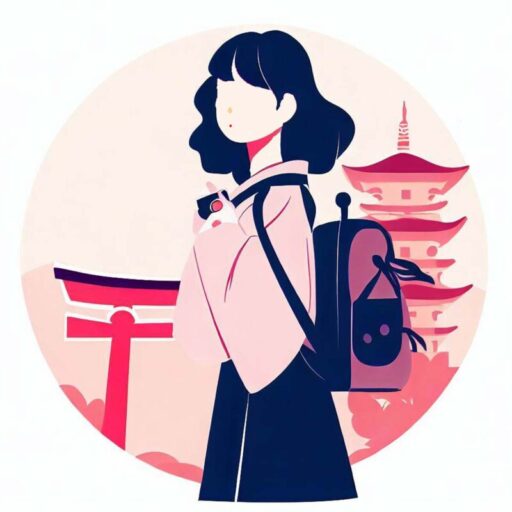Exploring the Traditions and Charms of Japan’s Winter Solstice! Detailed explanations from origins to modern ways of enjoyment. The 24 Solar Terms and the 72 Seasonal Divisions are also discussed.

『 This article is… 』
Explaining the customs and history of the Winter Solstice region by region. Packed with tips for experiencing special moments with family and friends while learning about traditions nationwide in Japan. Recommended for those interested in Japanese culture and those looking to enjoy events with family. Let’s deepen our understanding of Japan’s Winter Solstice and experience its rich culture!
Hello, I’m Kasumi, a travel web writer exploring Japan from coast to coast. Today, I’d like to talk about one of the heartwarming events deeply rooted in our lives throughout the year: the Winter Solstice. It’s not just a seasonal event; understanding its history, customs, significance, and regional variations can add richness to our daily lives.
Join me as we explore the charm of the Winter Solstice, incorporating my experiences traveling through all 47 prefectures of Japan. From tracing its evolution from history to modern times to unraveling Japan’s unique customs and their meanings, I’ll provide tips for a deeper understanding and enjoyment of the Winter Solstice. Let’s embark on this journey together!
Winter Solstice: Origin and Meaning
Winter Solstice, or “Touji” in Japanese, refers to the day when the sun is positioned farthest south, resulting in the shortest daylight hours of the year. This day marks the beginning of increasing daylight hours, symbolizing the “rebirth of light” and “rebirth of life.” It is one of the 24 solar terms and is celebrated not only in Japan but also in various parts of the world.
Origin of Winter Solstice in Japan
In Japan, Winter Solstice has been considered a special day since ancient times. Based on the Yin-Yang and Five Elements philosophy imported from ancient China, this day is regarded as a crucial turning point where the energy of “Yang” begins to regenerate. As a result, various customs have been developed to dispel evil and invite blessings.
Customs of Winter Solstice
While there are various customs associated with Winter Solstice, two particularly well-known ones are taking a yuzu bath and eating kabocha (pumpkin). The tradition of taking a yuzu bath originates from the belief that the scent of yuzu dispels evil spirits, warms the body, and prevents colds. Similarly, eating kabocha is a practice passed down for its nutritional value and long shelf life, helping people endure the winter.
Regional Characteristics
Each region of Japan has its own unique customs related to Winter Solstice. For example, in Nara Prefecture, there is a traditional event called “Yuzu-zome” where cloth dyed with yuzu is considered a charm for health and longevity. In Okinawa Prefecture, Winter Solstice, known as “Touji-yuu,” is celebrated with family gatherings and special meals. Understanding these regional customs adds depth to the meaning of Winter Solstice.
My Experience
One of the most memorable experiences I had was participating in Winter Solstice customs in a small fishing village. The villagers prepared special Winter Solstice dishes using freshly caught fish from the sea. Each dish carried wishes and the warm moments spent with family encapsulated the true essence of Winter Solstice.
Characteristics of Winter Solstice and Modern Enjoyment
Characteristics of Winter Solstice
Winter Solstice marks the shortest daylight hours of the year, symbolizing the “rebirth of the sun” and the beginning of hope as the days gradually lengthen towards spring. Additionally, due to the increasing cold, there is a focus on warming rituals and special dietary considerations during this time.
Modern Enjoyment of Winter Solstice
In modern times, while traditional customs are still cherished, new forms of enjoyment have emerged. For example, sharing Winter Solstice customs through social media allows more people to participate. Additionally, modern adaptations such as yuzu baths with aromatherapy or pumpkin dishes tailored to health-conscious lifestyles have become popular.
Wellness Aspect of Winter Solstice
With increasing interest in health and wellness, Winter Solstice is viewed as an opportunity to care for both body and mind. Taking a yuzu bath not only provides relaxation but also promotes a balanced and healthy lifestyle when combined with seasonal ingredients like kabocha.
Discovery of Regional Cultures Through Winter Solstice
Exploring regional cultures through Winter Solstice is a unique pleasure of modern times. Learning about and experiencing the diverse ways Winter Solstice is celebrated across different regions has become popular through tours and events, contributing to the revitalization of local economies.
Creation of New Traditions at Home
In contemporary households, there is a trend towards creating original traditions associated with Winter Solstice. For instance, enjoying a family movie night after relaxing in a yuzu bath or indulging in homemade kabocha sweets are ways to personalize the Winter Solstice experience.
My Thoughts
Each Winter Solstice offers an opportunity to reconnect with nature and people, making it a special day to cherish. Through my travels, I have learned about various Winter Solstice customs and their profound meanings. Amidst the busyness of modern life, Winter Solstice serves as a reminder to slow down, appreciate nature, and spend meaningful time with loved ones. It is a day that teaches us valuable lessons and instills hope for the future.
The Customs and History of Winter Solstice
Roots of Winter Solstice Customs
Winter Solstice customs are deeply rooted in the lives and beliefs of the Japanese people since ancient times. Throughout history, the Japanese have coexisted with nature and cherished the changing seasons. Winter Solstice has been regarded as a significant milestone in the natural order, marked by various rituals and ceremonies.
History of Winter Solstice
Winter Solstice has been celebrated not only in Japan but in many cultures worldwide. In Japan, influenced by religious practices such as Yin-Yang philosophy and Buddhism since ancient times, various rituals have been performed on Winter Solstice to honor gods and ancestors, praying for fertility and family safety.
Regional Customs and Origins
Each region of Japan has its unique customs and traditions related to Winter Solstice. For example, in Hokkaido, there is a tradition of eating mochi on Winter Solstice, symbolizing the importance of family bonds and praying for a bountiful harvest. Similarly, in Kyoto, there is a custom of eating wheat porridge called “awase,” performed to pray for abundant harvests and to warm the body.
Meaning of Winter Solstice in the Modern Era
In modern Japan, the significance and customs of Winter Solstice have evolved with changing times, but its fundamental meaning remains unchanged. Winter Solstice is considered a special day of the year, emphasizing harmony with nature and the importance of family bonds. Especially in today’s busy and stressful society, Winter Solstice holds new significance as a time for relaxation and healing.
Personal Reflection
Learning about the customs and history of Winter Solstice not only helps understand Japanese culture and tradition but also provides an opportunity to reconnect with nature and important values. Through my travels, I have been deeply impressed by the richness and depth of Winter Solstice customs and history. I believe that Winter Solstice, a day that reminds us of essential things we often overlook, should be eagerly anticipated every year.
Current and Future Winter Solstice Customs
Modern Winter Solstice Customs
In contemporary Japan, Winter Solstice customs are being continued in new forms. For example, it is common to gather with family and friends to enjoy meals on Winter Solstice. In addition to traditional dishes, incorporating new culinary arrangements and international cuisine allows for a more diverse culinary experience. Furthermore, relaxation facilities such as hot springs and spas are popular during the Winter Solstice season, serving as places for stress relief and health promotion.
Outlook for Future Winter Solstice Customs
Winter Solstice customs are evolving to adapt to changes in modern lifestyles and values. Events and tours aimed at deepening interactions with family and friends on Winter Solstice are being organized, attracting public interest. Moreover, there is a growing movement among people striving for sustainable living to appreciate nature and value local ingredients and traditional foods, leading to a reevaluation of Winter Solstice as part of this trend.
Suggestions for Enjoying Winter Solstice
To enjoy Winter Solstice, I propose spending time with family and friends in nature. For example, enjoying picnics near mountains or rivers or visiting hot spring resorts for refreshment would be delightful. Additionally, participating in local Winter Solstice customs or events can deepen cultural exchanges with the community. Winter Solstice offers an opportunity to feel harmony with nature and connections with others, discovering new values.
Personal Thoughts
I believe that Winter Solstice is a special day that allows us to feel the connection between nature and people. Through my travels, I have learned about various Winter Solstice customs and history, experiencing their richness. While modern life often keeps us busy, I find that spending Winter Solstice slowly, facing nature, and sharing time with loved ones enriches the soul. Winter Solstice reminds us of the natural order and important values, offering new hope for the future.
Conclusion and Reflection
Winter Solstice is an important day symbolizing Japanese tradition and culture, cherished by many people from ancient times to the present. While preserving traditional customs passed down from antiquity, new ways of enjoyment and meaning are added to Winter Solstice, expanding its charm.
Welcoming Winter Solstice is an opportunity to cherish harmony with nature and family bonds, eagerly awaited every year. Through my travels across Japan, I have learned about various Winter Solstice customs and history, deepening my appreciation for their richness and depth. Each custom and tradition carries the hopes and aspirations of people, and understanding their significance enhances the allure of Winter Solstice.
Winter Solstice provides an occasion to express gratitude for the blessings of nature and to cherish time with loved ones. Preserving and conveying the rich meaning of Winter Solstice is essential for safeguarding Japanese culture and tradition, connecting us to the future.
Kasumi Points
Hokkaido: Tradition of Eating Mochi
Prefecture: Hokkaido
Kasumi Point: In Hokkaido, there is a tradition of eating mochi on Winter Solstice. Mochi is considered auspicious, symbolizing family bonds and abundant harvests. Additionally, it is valued for providing energy to endure the harsh cold.
Aomori: Tradition of Eating Pumpkin Dishes
Prefecture: Aomori
Kasumi Point: Aomori has a tradition of eating dishes made with pumpkin on Winter Solstice. Pumpkins are rich in nutrients necessary for the winter season, and consuming them also carries prayers for good health.
Kyoto: Tradition of Eating Wheat Porridge
Prefecture: Kyoto
Kasumi Point: In Kyoto, there is a tradition of eating wheat porridge, known as “awase,” on Winter Solstice. This porridge is eaten to pray for a bountiful harvest and to warm the body against the winter cold.
Okinawa: Tradition of Gathering with Family and Eating Special Dishes
Prefecture: Okinawa
Kasumi Point: In Okinawa, Winter Solstice is called “toujiyuu,” and there is a tradition of families gathering to enjoy special dishes. This custom is meant to strengthen family bonds, and sharing Okinawan cuisine is believed to enhance familial ties.
Nara: Tradition of Yuzu Dyeing
Prefecture: Nara
Kasumi Point: In Nara, a traditional event called “Yuzu-zome” is held on Winter Solstice. Yuzu-zome is a dyeing technique using yuzu citrus peels, and the dyed fabric is treasured as an amulet for health and longevity. This event preserves ancient traditions and passes down regional culture to future generations.
These regional characteristics are rooted in each area’s history, culture, and climatic conditions. Understanding these regional traits allows for a deeper appreciation and understanding of the diversity and richness of Winter Solstice traditions.






